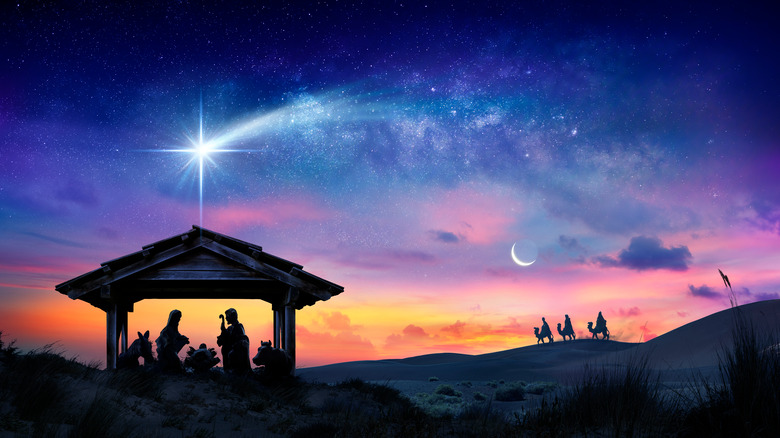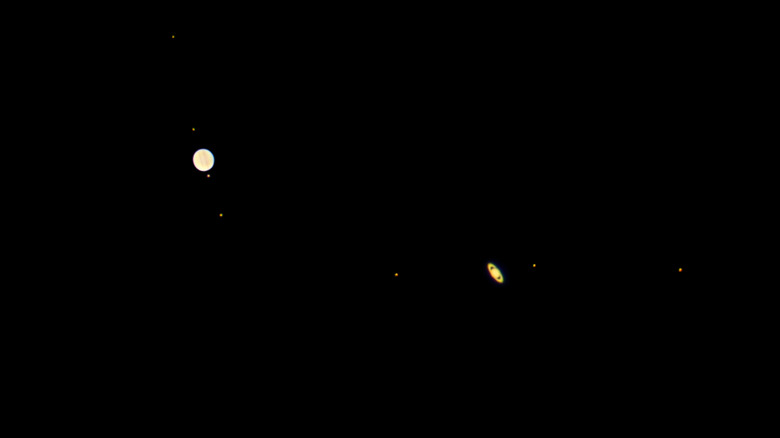The Star Of Bethlehem Explained By Science
In the story of Christmas outlined in the Book of Matthew, three wise men follow a star in the eastern sky, first to Jerusalem and then to Bethlehem (via Bible Gateway). For centuries, people have wondered if there was a scientific basis behind this story — did the Magi see a comet? A supernova? A solar flare?
Like all stories that come from faith, there will probably never be a definitive answer. Historians, after all, don't even have an exact date for the birth of Jesus. Britannica places this event sometime between 6 B.C. and Judea King Herod's death in 4 B.C., because Herod is mentioned in at least two of the nativity stories. But, if the Star of Bethlehem really existed and was not just a literary device, scientists and historians do believe that some explanations are more likely than others.
"If what is in the New Testament is a historical account of something, then that historical account requires an explanation," David Weintraub, a professor of physics and astronomy at Vanderbilt University, told Space. "As an astronomer, you want an astronomical explanation."
The bad kind of omen
Scientists are pretty sure about what the Star of Bethlehem definitely was not. It couldn't have been a meteor — those are bright for just an instant (via Astronomy). There were no supernovae visible around the time of Jesus' birth — the closest one happened in A.D. 185, according to accounts of Chinese astronomers, who made consistent records of astronomical events.
It might have been a persistent comet — there was one visible in the sky around 5 B.C., again according to Chinese records from the period, and Halley's Comet was visible just a bit earlier, in 11 B.C. (via Space). But comets in the ancient world were usually seen as bad omens, not good ones. "For Christmas cards, it makes a nice picture having a comet and a tail, but in those days comets up in the sky were usually a harbinger of impending disaster," said Grant Mathews, an astrophysics professor at the University of Notre Dame, per Space. Besides that, a comet would have changed its position in the sky throughout the night — it wouldn't have led the Wise Men in a single direction.
A great conjunction, or astrology
Instead, there are two other possibilities. The one that matches most closely to our traditional view of the Star of Bethlehem is a great conjunction, where multiple planets appear to meet in the night sky in a single location (via Space). There are several conjunctions over the period of time in which Jesus was likely born, including one, in 6 B.C., that occurs during the morning, fitting the interpretation of the Star of Bethlehem as a rising morning star.
The other interpretation is astrological. In the Biblical account from Matthew (via Bible Gateway), the only book in which the story of the Magi occurs: "Now when Jesus was born in Bethlehem of Judaea in the days of Herod the king, behold, there came wise men from the east to Jerusalem, saying, 'Where is he that is born king of the Jews? For we have seen his star in the east, and are come to worship him.'" The fact that they needed to ask for directions may signify that the star was more symbolic than literal — perhaps they had seen astrological portents heralding the birth of the king of the Jews, such as Jupiter entering Aries on April 17, 6 B.C., which would have been associated with royalty. Though astrology isn't necessarily scientific, it would have been in wide use in those days, especially among learned "Wise Men" traveling from eastern kingdoms.


